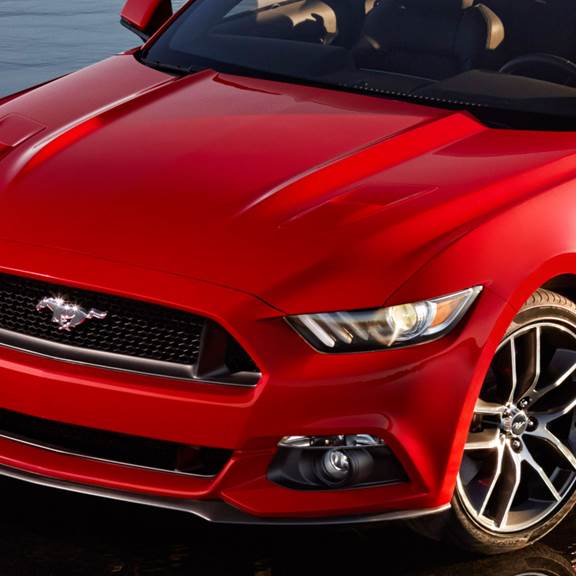Cutting-edge design embodies the performance beneath
Because it fades away the moment you see the new car, it’s good to recall that originally the sketch pads were blank. Ford could have gone anywhere with the ’15 Mustang’s design, but as we see, they avoided many temptations and executed a sublimely evolutionary step forward.
Certainly the core Mustang proportions of a long hood and short rear deck remain, but this sixth major iteration of the Mustang expertly amplifies the marques primal masculinity while adding new sophistication. In fact, the gesture is brutal – the green house now disproportionately small relative to the larger, chiseled body – but the details are so elegantly cut as to suggest an Aston Martin rather than some of the cartoonish muscle cars stamped out elsewhere in Detroit.

Chief architect of the ’15′s beauty is Joel Piaskowski, director of exterior design at Ford. He had the huge task of balancing the conflicting needs of conservative Mustang traditionalists, Mustang futurists, and Mustang intenders identified by Ford’s market research. Additionally, Ford’s corporate hierarchy wants corporate family cues, such as the Evos grille, all of which seemingly doesn’t leave much room for creativity. The sophisticated ’15 sheet-metal says otherwise.
Key to the ’15′s persona is that seemingly smaller greenhouse and larger fender flares. In reality, the greenhouse is approximately the same size – Ford was quick to confirm the interior is actually larger than the previous S197 design – and key to the car’s physique is a 70mm increase in rear track width. Coupled with a 15mm increase in front track, the effect is much more three dimensional than before, with a bulge and flow new to Mustang.

Joel explained the effect: “The current car is what I would call more of a two-dimensional design, with a side, front, and rear. Where this has been designed and modeled in such a way that it is three-dimensional. It engages the viewer to come explore, see, and appreciate the sensuality.”
Knowing the rear track increase was requested and executed long after the IRS was designed and the associated structure was in place shows just how important it is to the overall design. Joel had to go to Mustang honcho Dave Pericak and sell the rear track increase on its design merits alone. The chassis and suspension engineers had already met their goals and had no dynamic need for the width increase. It meant tremendous re-engineering of every-thing under the new skin, but everyone, including the chassis engineers who had to put out the extra effort, agree it was worth it.
That such a late change was even possible is thanks to an accelerated development schedule that sees design and engineering occurring simultaneously. This requires dedicated packaging teams to provide the liaison between design and engineering, but because the process is completely computerized, the files are easily shared between the two disciplines and can still be changed.

With the rear track widened, the discussion turned to again increasing the front track. For handling reasons, it had been widened 15 mm early in the program; much later the rear track was increased. Ultimately the team decided not re-widen the front track, but it was a close decision.
Not discussed was the obvious need to bring all the tire faces flush with whatever new sheet-metal was decided upon. This has been a weak point of recent Mustang design, allowing something of a muffin top flare over the rear tire, and Joel was determined to be rid of it. Thus, the rear track traveled 70 mm outward, but the body-work increase is just 40 mm to keep fender and tire aligned vertically.